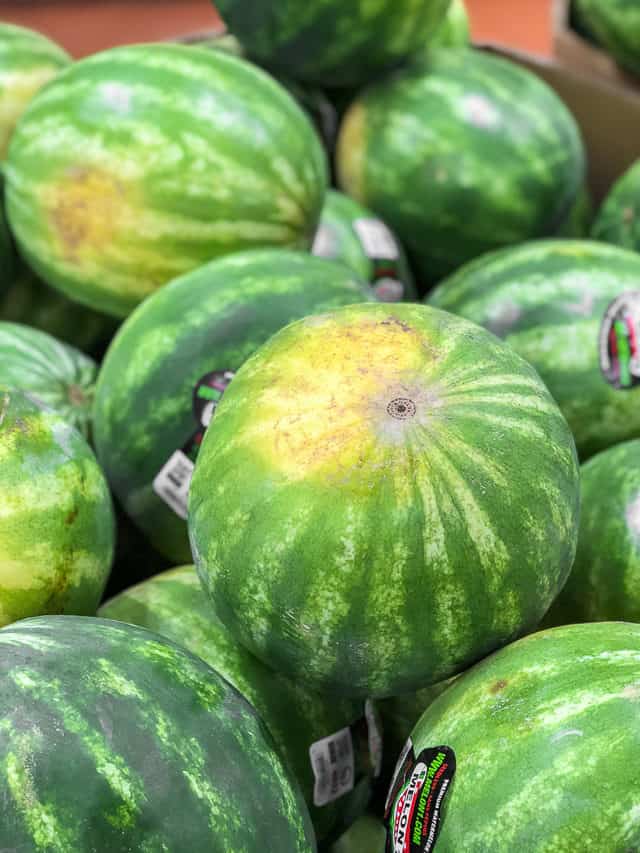How to Tell If Watermelon is Bad: Freshness Hacks!
To tell if a watermelon is bad, examine its color and texture or smell for any signs of sourness or fermentation. When knocking on it, a good watermelon will sound hollow; a dull sound may indicate spoilage.
Enjoying a fresh, juicy watermelon can be the epitome of summertime bliss, and knowing how to select a perfect melon is essential for that perfect picnic or barbecue. Watermelons that are past their prime not only lack flavor and sweetness but can also be a health risk.
This guide will equip you with the necessary information to ensure you always choose a ripe, delicious, and safe watermelon. An understanding of what to look for in color, feel, and sound can mean the difference between a refreshing treat and a disappointing experience. Keep these tips in mind the next time you’re navigating the produce aisle or farmer’s market for that perfect slice of summer.

The Lifecycle Of A Watermelon
Watermelons grow from vines on the ground. They need sun and time to become ripe. Once picked, their freshness starts to decrease. Store them in a cool place. Uncut watermelons last about 7–10 days. If sliced, eat within 5 days.
External Telltale Signs
Checking watermelon skin is crucial. A shiny appearance indicates over-ripeness.
Look for a dull finish for a fresh watermelon. Dark spots or bruises suggest damage. Mold or mildew presence shows spoilage.
Thumping the watermelon can help too. A deep hollow sound often means it’s ripe and good. A flat or dull sound might mean it’s bad or unripe.
Internal Warning Flags
Spotting a bad watermelon involves checking for certain signs. One key indicator is the melon’s color. Ripe watermelons typically have a vibrant green rind and a deep red or pink flesh. If the color appears dull or the flesh has white streaks, it could mean the fruit is bad. Furthermore, the texture should be firm. Spongy or overly soft spots suggest spoilage.
Conducting a sniff test is another effective strategy. A fresh watermelon will have a mildly sweet and pleasant aroma. An unpleasant, sour, or musty smell is a clear sign of a spoiled watermelon. Trust your nose – if it smells off, it’s best to avoid eating the watermelon.
:max_bytes(150000):strip_icc()/how-to-tell-if-honeydew-Melons-are-ripe-2x1-db5f3d4b79d042428f0d9ff09a96ea7c.jpg)
Taste And Freshness
Sampling for flavor reveals if a watermelon is spoiled.
Bad watermelons taste sour or bland.
Good ones are sweet and juicy.
- Color can change – a white or pale spot may appear.
- Texture might be spongy or dry.
- A sniff test may reveal unpleasant odors.
Storage And Preservation Tips
To keep watermelons fresh and tasty, follow these simple storage and preservation tips. Best practices for longevity include keeping your watermelon in a cool, dark place. Ideally, store them in your refrigerator to extend freshness.
Always wrap the cut watermelon in plastic. This helps prevent it from absorbing other food odors. Avoid leaving watermelon at room temperature for more than two hours. Doing so can make it spoil faster.
Watch out for common storage pitfalls:
- Do not store watermelon with ethylene-producing fruits, like apples or bananas.
- Keep the watermelon dry to resist mold growth.
- Avoid placing any heavy items on top of the watermelon.

Safe Consumption Practices
Determining when a watermelon has gone bad is key to ensuring food safety. If the exterior of the fruit shows bruising, cuts, or mold growth, it’s a clear indication the watermelon is no longer good. The inside should also be examined. Discoloration, slimy flesh, and an unpleasant smell signify spoilage. These signs help you decide to discard the fruit to avoid consumption.
Consuming spoiled watermelon carries health risks. It can lead to foodborne illness. Symptoms can include stomach pain, nausea, and vomiting. Young children, pregnant women, and people with weak immune systems should be particularly careful with fruit selection. Always practice good hygiene and proper storage techniques with all fruits to reduce these risks.
Frequently Asked Questions Of How To Tell If Watermelon Is Bad
What Are Signs Of A Spoiled Watermelon?
Signs of a spoiled watermelon include a mushy, soft texture, an off smell, and a lackluster or discolored rind. If the flesh looks slimy or discolored and the seeds are mushy or have lost color, it’s gone bad.
How Long Does Watermelon Last Once Cut?
Cut watermelon can last in the refrigerator for about 3-5 days. It should be covered in plastic wrap or stored in an airtight container. If it’s left out at room temperature, consume it within a few hours to prevent spoilage.
Can You Eat Watermelon Past Its Expiration Date?
If the watermelon shows no spoilage signs such as bad smell or discoloration, and it’s only slightly past the expiration date, it may still be safe to eat. However, prioritizing freshness and food safety is key.
What Is The Best Way To Store Watermelon?
The best way to store whole watermelon is in a cool, dark place, away from direct sunlight. Once cut, store it in the refrigerator in an airtight container or wrapped up to maintain freshness.
Conclusion
Knowing when to toss a watermelon ensures you enjoy only fresh, sweet fruit. Observe its weight, surface, and smell. A bad one is usually lighter, with a dull appearance and peculiar odor. Always trust your senses; they’re your best guide to avoiding spoiled or unripe watermelons.
Stay refreshed and healthy by choosing wisely!
